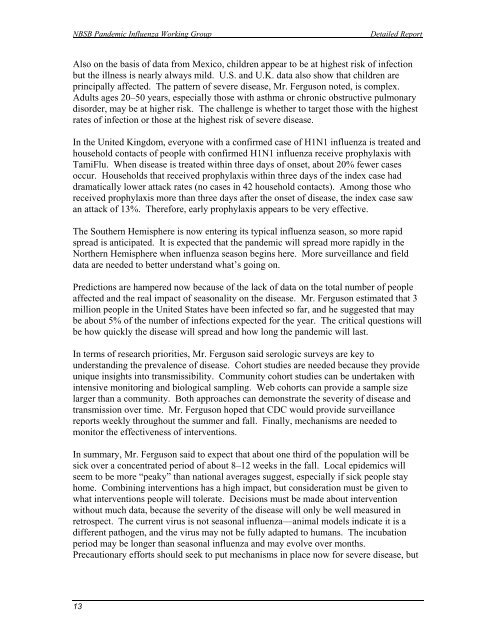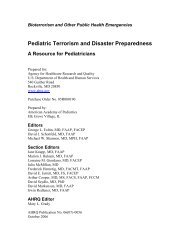H1N1 COUNTERMEASURES STRATEGY AND ... - PHE Home
H1N1 COUNTERMEASURES STRATEGY AND ... - PHE Home
H1N1 COUNTERMEASURES STRATEGY AND ... - PHE Home
Create successful ePaper yourself
Turn your PDF publications into a flip-book with our unique Google optimized e-Paper software.
NBSB Pandemic Influenza Working Group<br />
Detailed Report<br />
Also on the basis of data from Mexico, children appear to be at highest risk of infection<br />
but the illness is nearly always mild. U.S. and U.K. data also show that children are<br />
principally affected. The pattern of severe disease, Mr. Ferguson noted, is complex.<br />
Adults ages 20–50 years, especially those with asthma or chronic obstructive pulmonary<br />
disorder, may be at higher risk. The challenge is whether to target those with the highest<br />
rates of infection or those at the highest risk of severe disease.<br />
In the United Kingdom, everyone with a confirmed case of <strong>H1N1</strong> influenza is treated and<br />
household contacts of people with confirmed <strong>H1N1</strong> influenza receive prophylaxis with<br />
TamiFlu. When disease is treated within three days of onset, about 20% fewer cases<br />
occur. Households that received prophylaxis within three days of the index case had<br />
dramatically lower attack rates (no cases in 42 household contacts). Among those who<br />
received prophylaxis more than three days after the onset of disease, the index case saw<br />
an attack of 13%. Therefore, early prophylaxis appears to be very effective.<br />
The Southern Hemisphere is now entering its typical influenza season, so more rapid<br />
spread is anticipated. It is expected that the pandemic will spread more rapidly in the<br />
Northern Hemisphere when influenza season begins here. More surveillance and field<br />
data are needed to better understand what’s going on.<br />
Predictions are hampered now because of the lack of data on the total number of people<br />
affected and the real impact of seasonality on the disease. Mr. Ferguson estimated that 3<br />
million people in the United States have been infected so far, and he suggested that may<br />
be about 5% of the number of infections expected for the year. The critical questions will<br />
be how quickly the disease will spread and how long the pandemic will last.<br />
In terms of research priorities, Mr. Ferguson said serologic surveys are key to<br />
understanding the prevalence of disease. Cohort studies are needed because they provide<br />
unique insights into transmissibility. Community cohort studies can be undertaken with<br />
intensive monitoring and biological sampling. Web cohorts can provide a sample size<br />
larger than a community. Both approaches can demonstrate the severity of disease and<br />
transmission over time. Mr. Ferguson hoped that CDC would provide surveillance<br />
reports weekly throughout the summer and fall. Finally, mechanisms are needed to<br />
monitor the effectiveness of interventions.<br />
In summary, Mr. Ferguson said to expect that about one third of the population will be<br />
sick over a concentrated period of about 8–12 weeks in the fall. Local epidemics will<br />
seem to be more “peaky” than national averages suggest, especially if sick people stay<br />
home. Combining interventions has a high impact, but consideration must be given to<br />
what interventions people will tolerate. Decisions must be made about intervention<br />
without much data, because the severity of the disease will only be well measured in<br />
retrospect. The current virus is not seasonal influenza—animal models indicate it is a<br />
different pathogen, and the virus may not be fully adapted to humans. The incubation<br />
period may be longer than seasonal influenza and may evolve over months.<br />
Precautionary efforts should seek to put mechanisms in place now for severe disease, but<br />
13
















